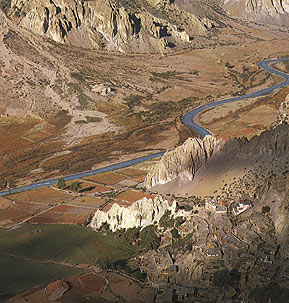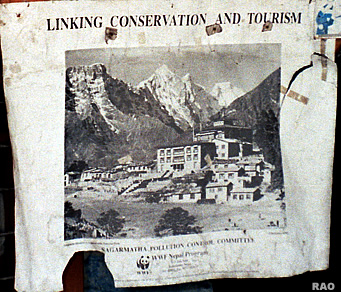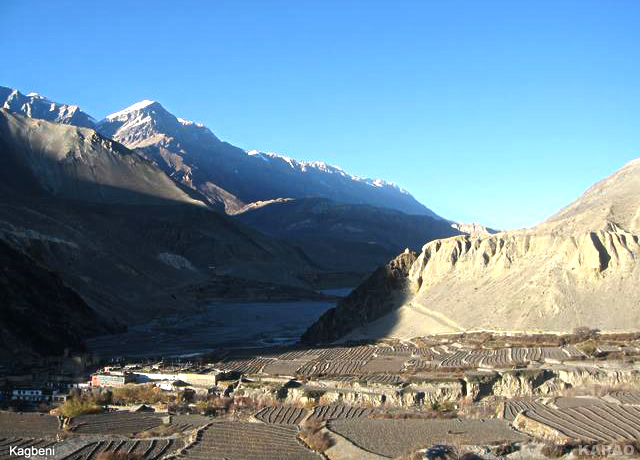 |
Nepal Trekkings |
|
 |
Nepal Information |
|
|

|
| Annapurna
Conservation Area Project (ACAP) in Lo Manthang |
ACAP
takes care of Upper Mustang
 |
| Annapurna
Conservation Area Project (ACAP) under King Mahendra Trust for Nature
Conservation (KMTNC) takes all care of this restricted area of Upper Mustang.
ACAP
which has been responsible for the sustainable development and management
of the natural resources of over 7000 square kilometres of wild natural
resources, including Himalayan sanctuary, trekking route and villages in
Nepal including parts of Mustang district, is aware of the growing problems
associated with environmentally unfriendly habits of the local people.
ACAP
faces uphill task of educating people about environmental and health hazards
associated with food habits. |
|
Early
in the morning an old lady comes with her locally made caned basket and
a broom picking up all the plastic and other litter that can be seen on
the streets of Lo Manthang in Upper Mustang. The streets of Lo Manthang
are not very clean but she also sweeps them and nicely tucks the plastics
that she collected from the streets.
 |
| The
environmental resource conservation, awareness and training programmes
initiated some years ago by Annapurna Conservation Area Project (ACAP)
seems to have started to bear fruits in the Upper Mustang region. Lo Manthang
looks cleaner despite its earthen roads, mud and wood houses, narrow lanes,
horses and cattle plying on them, stack of their forages and the heaps
of barley dumped on the road sides after the annual harvest. The tiny Himalayan
hamlets of Kagbeni, Tangbe, Chhuksang, Chele, Samar, Ghemi, Tamagaon, Charang,
Lo Manthang, Chhoser in Upper Mustang, each has a separate religious and
sociocultural identity. The houses in Chhoser, around two hours walk from
Lo Manthang on the east, present their distinct identities. |
|
Cave
houses half-embedded into the mountain slopes with their main entrances,
windows and gates seem to be structures stuck on the mountain sides from
outside. These cave dwellings look interesting and cozy. Caves and holes
on the ridges of the Kaligandaki river are common sights between Eklobhatti,
Muktinath and in Lo Manthang area but cave houses built on hill slopes
at Chhoser are far more superior and different.
Clean
blue sky, swinging trees, some seasonal green vegetables in the kitchen
gardens are becoming part of Upper Mustang, thanks to ACAP are encouraging
local people to grow more vegetables and consume more of them as a regular
diet with their meals. Vegetables didn't exist in Lo Manthang before
ACAP came here. The staple diet of people at Lo Manthang normally includes
meat and potatoes.
Looking
at the broken coloured glasses on the street sides, fields and in the garbage
dumps constructed by the local people, one can easily imagine that people
in Upper Mustang are getting into the habit of drinking more beer than
Chang and Tomba, their local drinks.
People drink these cheap beer a lot
these days, more than they drink other local drinks and leave the bottles
here and there. The several trucks come daily up to Lo Manthang.
In fact ACAP also use these trucks to transport timber from Tibet for the
restoration work at the ancient Thuptchen monastery. ACAP is selling empty
bottles and cans back to China for recycling purposes.
Upper
Mustang is a remote area. It is out of reach of government's presence and
development activities. Although still restricted for foreigners but they
visit the area in abundance. Lo Manthang and many other Himalayan settlements
are like corps left for cultures, which they can tear at their will. The
half-fallen police post manned by a few police personnel is not enough
to stay guard and protect this area.
This area has enormous potential
for antisocial elements to conduct their traffickings in any item that
they require. It is the same area from where Karmapa and his gang quietly
slipped into Nepal and then into India, embarrassing Nepalis government.
What this area now needs is strong government presence in the form of Army
and police. In winter all the young and rich migrate to warmer places like
Pokhara and Kathmandu or go to India for business.
 |
|
Annapurna
III |
| ACAP
targeted by Maoists |
 |
In
2001, when the emergency was declared, NGOs were targeted but all of ACAP's
offices were operational until September this year. After the peace talks
broke down in August 2003, the Maoists came to Ghandruk and destroyed the
ACAP office, telling staff not to return. ACAP had to close all our offices
in the southern belt.
top
| more information on Nepal |
 |
|
Links
|
 |
 |
 |
External
links |
|
|
 |
King
Mahendra
Trust
for Nature Conservation (KMTNC) |
|
|








